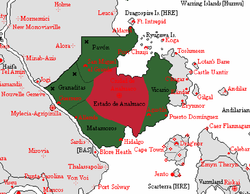Estado de Anahuaco
| Anahuaco State Estado de Anahuaco |
|
|---|---|
| State of Anahuaco | |
 |
|
| Nation | |
| Capital | Ciudad de Anahuaco |
| Population | |
| • Total | ~35 million |
Anahuaco State (Martino: Estado de Anahuaco) is the largest and most populous state of Anahuaco, and is also home to the capital city, Ciudad de Anahuaco.
Famous for its mountainous terrain, high altitude, fertile farmland and upland freshwater lakes, the state is considered to be the cradle and critical cornerstone of the Anahuacan Empire.
History
Dating back to the pre-Anahuaco era, the territory of Anahuaco State has always played a pivotal role in the history of the region. The empire's capital, Ciudad de Anahuaco, has a long history that predates the arrival of the Martino-speaking population.
Since being founded sometime around the year 700, the city's position in the midst of the rich, fertile uplands has made it a key trading post, with many traditional transit routes converging in the area. While little is known about the early history of the settlement, archaeological remains indicate that the area was home to intensive agriculture, as well as thriving trade in agricultural tools and produce. The remains of several significant storehouses have been of particular note, containing hundreds of clay storage vessels, as well as coins and other metal objects.
The state around Ciudad de Anahuaco has been intensively farmed over the centuries, with moderate and predictable weather, as well abundant rainfall, making it ideal for growing sustenance crops as well as a variety of fruits.
The establishment of Ciudad Grande cemented the region's prominence, making it the logical capital region when Anahuaco was created in its modern form.
Government
In common with all the states of Anahuaco, Anahuaco State directly elects a state legislature using a proportional voting system, with universal suffrage for citizens over the age of 16.
The head of the state government is a governor appointed by the Emperor. The current Governor of Estado de Anahuaco is Juan Manuel Martinez.
Unique among the states of the empire, the state government of Anahuaco does not govern the entire territory of the state. This is because, while Ciudad de Anahuaco falls within the boundaries of the state, it is governed as a federal territory under the jurisdiction of a council made up of the governors of each of the five states.
Geography
The geography of the state is dominated by the Sierra del Sur mountain range, the two branches of which create a natural border for the state on the north, east and west sides. Between the two branches of the mountain range, a high plateau stands at 2000m above sea level. Much of the state's usable land stands on this plateau, including Ciudad de Anahuaco. On either side of the plateau, mountain peaks are visible on clear days.
The highest mountain in the empire, El Cerro Del Guaymas, stands at 3421m and can be found in the far north of Anahuaco State.
Culture
As the capital of the Empire, Ciudad de Anuhuaco is home to a wide range of nationally renowned cultural institutions. These include the national opera house, natural history, art and military museums, as well as a cluster of privately run collections. In addition to these traditional cultural institutions, the city is home to a thriving music and street art scene, with up and coming artists from across the Empire choosing to make their homes in the city.
The result is a culturally sophisticated city, which is sometimes derided as pretentious by those living elsewhere in the Empire.
Issues
Due to the city's large, dense population and poor enforcement of planning regulations, Ciudad de Anahuaco suffers from a range of problems. The city's rudimentary public transport system, which consists of one metro line and a patchwork of privately operated bus companies, has resulted in crippling traffic congestion in much of the city. While the historic centre has traffic control measures in place, as well as large pedestrianised areas, the rest of the city routinely suffers from gridlock. Coupled with the city's low average income, and the older cars that result from it, this has given rise to high levels of air pollution, with a visible smog hanging over the city on most days.
Many of the city's other problems (including unreliable waste collection and lackluster emergency services) stem from this fundamental problem. As a result of this, the city's governing council has made it a priority to resolve the city's traffic problems by developing comprehensive public transport.